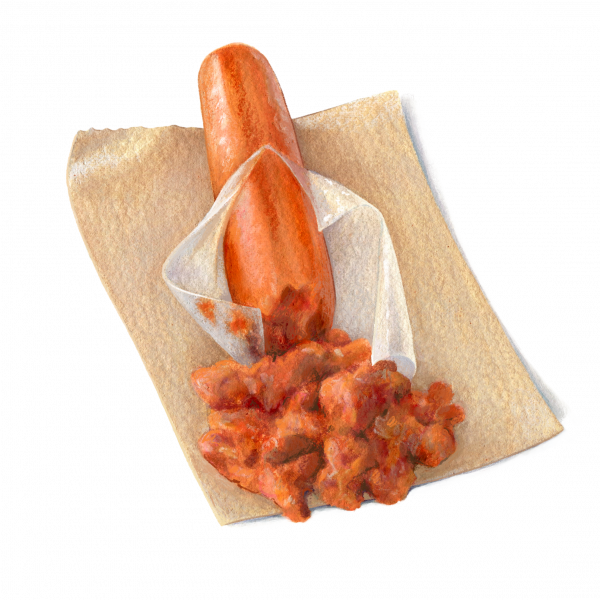Though they share a name and vibrant red color, Spanish and Mexican chorizos differ in form and flavoring.

Spanish chorizo is a firm, cured sausage made from pork—often the shoulder—that’s ground together with paprika. Sherry, salt, garlic and other spices are often included in the mix as well. After blending, the meat is air-cured for a couple of days, then stuffed into casings, tied and hung to dry. Spanish chorizo has numerous regional variations. It can be hot or sweet, depending on the type of paprika used, and sometimes the sausage is smoked after drying. Palacios is a reliably good, widely available brand in the U.S. We like to use Spanish chorizo as charcuterie, or as a way to give a dish potent flavor and meaty texture, as it does for our carcamusa. Try rendering a bit of chopped Spanish chorizo in oil for frying eggs or cooking greens, potatoes or chickpeas—the oil will carry the sausage’s rich flavor into any dish.

In contrast to Spain’s version, Mexican chorizo is fresh and flavored by adobo—a highly variable blend of chilies, spices and vinegar. Though it’s mostly made with finely minced ground pork, which gives the cooked chorizo a crumbly texture, beef is also common. After the meat is mixed with adobo, it may be stuffed into casings and aged for a short amount of time, typically less than a week. It can also be purchased in its loose form, which resembles ground pork. In either form, Mexican chorizo must be cooked. Look for it in Latin markets. We sauté fresh chorizo in a small amount of oil, then use it as a spicy, porky filling for omelets, quesadillas, tacos and grilled cheese sandwiches.
I had my first tapas in Spain back in June 1969 as I was passing through Madrid, driving down to the ferry to Tangiers. Slices of inky-black blood sausage and neatly marbled squares of jamón Ibérico, silver-white anchovies swimming in white vinegar, wedges of eggy tortilla—consumed as the evening dwindled into the night and well past, mostly eaten while standing, and all washed down with short glasses of beer. The small plates, late-night dining and unusual offerings were new to me then, but would become familiar over time.
Still, the notion of thinking of tapas as a brilliant lesson in quick cooking did not occur to me until recently, when I returned to Madrid to work with chef Abraham García. García has been working in Madrid’s kitchens since he was 13. He is the owner of Viridiana, a white-tablecloth restaurant that mixes old and new. On this visit, I was more interested in the old.
I had come to learn to make carcamusa, a piquant mix of cubed pork, sliced chorizo, chunks of cured Spanish ham, spices and tomato puree that’s served as a tapa. As I watched the bespectacled chef prepare the dish—a process he completed in well under 30 minutes—it became clear that this was a skillet stew. And since stews are never quick affairs, there was something special going on in his kitchen.
That something was the use of powerful cured meats—jamón and chorizo, which need no cooking to contribute bold flavor—plus small cubes of pork that would cook quickly. Added to that mix are garlic and spices, and in just half an hour, you have a full-flavored stew. Brilliant.
Back at Milk Street, we didn’t have easy access to Spain’s deeply savory ham. Instead, we doubled down on chorizo, which we could easily find in mainstream stores (see sidebar), on the many differences between Spanish and Mexican chorizo). We used the cured, paprika-laden pork sausage as the main flavoring for our take on carcamusa. After removing it from its casing, we could thinly slice, then process the chorizo with garlic, dried oregano, cumin and some juice from a can of whole peeled tomatoes. That formed a potent paste that we used two ways: half to marinate the pork and the other half to flavor the tomato base for the stew.
García used a shoulder cut of pork, which still had some chew to it after the short cooking time. Europeans tend to prefer chewy meat; here in the States, we opt for tenderness. So we switched to tenderloin, which we cut into ½-inch pieces. Though García did not brown his meat—he simply placed it into the simmering liquid—we felt this step added enough extra flavor to be worth five minutes of sauteing.
After the hunks of pork tenderloin were well browned, we set aside the meat to make the stew itself. We browned onions, then added dry sherry (look for fino or manzanilla—not cooking sherry) and reduced it in the skillet. In went the chorizo-tomato puree, plus more tomato juice. After 10 minutes of simmering, the flavors were melded. For fresh flavor and a sweet accent, we added more slices of chorizo and roasted red pepper just at the end.
Carcamusa is easily made ahead of time and reheated; it actually tastes better the second day, as the chorizo imparts deeper flavor as it sits. It is usually served with a rough, chewy bread, though you could easily opt for either rice or potatoes. Some recipes we saw added frozen peas to make it a more complete one-pot meal, but we preferred the simplicity of García’s approach. Tapas are not casseroles, after all; their simplicity and clear flavor profile are the appeal.
Related Recipes
September-October 2018

Sign up to receive texts
Successfully signed up to receive texts!
We'll only send our very best offers - Like a $15 store credit to start.
By entering your phone number and submitting this form, you consent to receive marketing text messages (such as promotion codes and cart reminders) from Christopher Kimball's Milk Street at the number provided, including messages sent by autodialer. Consent is not a condition of any purchase. Message and data rates may apply. Message frequency varies. You can unsubscribe at any time by replying STOP or clicking the unsubscribe link (where available) in one of our messages. View our Privacy Policy and Terms of Service.



